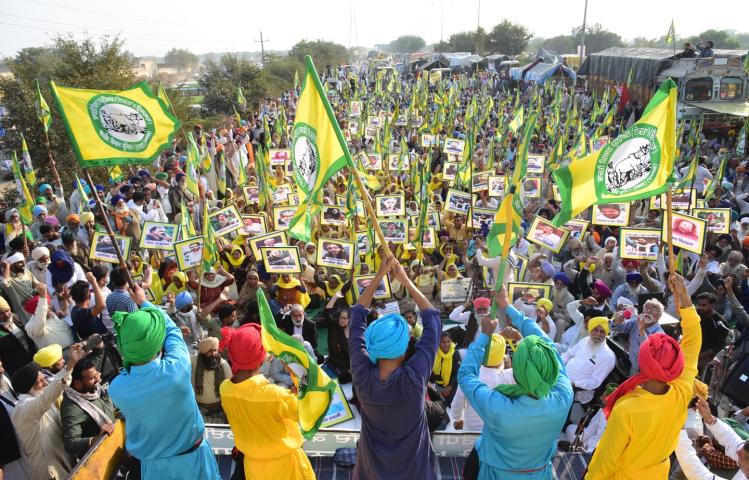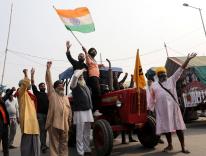
More than thirty years ago, I boarded a night train to Delhi with my young children. They were fast asleep in our reserved berths when the train stopped in Haridwar, India’s holiest city. I glanced out the window, expecting the usual crowds of pilgrims and sadhus, but saw instead what looked like a sea of farmers—tall, lean men in white khadi kurtas and green scarves. They surged en masse onto the train, first filling the unreserved compartments and then pouring into the reserved ones. Ignoring the ticket collector’s feeble attempts to stop them, they forced their way in, shouting slogans like “Kisan ki jai!” (“Victory to the farmer!”). They were on their way to Delhi for an enormous farmers’ rally the next day, and nothing was going to stop them.
The children and I were now huddled on one of our three berths as more and more men fought their way into the train car and simply parked themselves on our bunk. Let’s just say it was a very long night. For months afterward, whenever the subject of trains came up, my little daughter Moy Moy’s eyes would widen as she said emphatically: “Moy train no go. Kisans.”
The idea of a child being terrified by farmers seems crazy—and it was. Once this mob of men had found seats (most were on the floor) and settled in for the night they were quiet, even courteous. And they were eloquent about the reason for their journey. “If you destroy a bird’s nest,” one of them said, “will it not cry out?” They insisted on sharing their food with us and when we pulled into Delhi, they helped with our luggage and found us a taxi. Moy Moy had no reason to be afraid of them.
The Indian government, on the other hand, has good reason to fear farmers. While farming makes up only 15 percent of India’s GDP, 50 percent of the population works in agriculture. Farmers are a massive voting bloc, incredibly creative and well organized, and they enjoy huge popular support. With half the country working the land, everyone here knows farmers personally.
Yet in September, during the height of the pandemic, with most of the country in lockdown, India’s ruling Bharatiya Janata Party pushed through three farming bills without consulting farmers or their unions. The bills were designed to deregulate the farming sector and open it up to major conglomerates. Protests erupted soon after the bills were enacted and have continued ever since. In November, an estimated 250 million farmers and their supporters took to the streets across the country; even now, several months later, thousands continue to camp out in Delhi demanding that the laws be repealed. On January 26, India’s Republic Day, violence broke out in a few parts of Delhi. The groups that organized the protests—which had been completely peaceful until then—claim the violence was instigated by outside agitators, but the government used the incident to impose draconian measures, cutting off electricity, water, and internet to the protest sites and arresting more than 120 people on charges of rioting and sedition.
Why are the farmers so angry? Soon after India won independence in 1947, droughts and floods caused repeated crop failures and famines. In a move to modernize farming, the government undertook the highly publicized Green Revolution with American support. The introduction of chemical fertilizers, pesticides, irrigation, and heavy machinery seemed like a boon initially, but it ultimately left large tracts of land infertile. Some crops were nearly wiped out entirely, especially the less profitable ones traditionally grown in drought-prone areas. But with massive government support, rice and wheat did remarkably well, resulting in a food surplus.
At this point, the government stepped in to establish a fair pricing system for certain crops. Under this system, which mainly benefits medium-to-large-scale farmers, produce is brought to wholesale local markets known as mandis, where it is sold in an open auction. For rice and wheat, a minimum support price (MSP) is set, and the government’s Food Corporation of India ends up buying most of these crops and distributing them at very low prices in ration shops throughout the country. Many state governments also provide free electricity and water for farmland.
While the mandi system isn’t perfect, farmers are convinced that it is the only thing standing between them and financial ruin. It is this system that the new farming laws would abolish. Under the new dispensation, electricity and water will no longer be provided for free and strict land-ceiling acts have been repealed, allowing corporations to snap up enormous tracts.
The first of the three new laws allows unregulated trade outside the mandi system. That’s already happening, of course, but the control prices at the mandis act as a benchmark for the open market. With the MSP no longer guaranteed, small and mid-size buyers fear they will be squeezed out of business, unable to compete with big corporations.
The second law removes current constraints on contract farming. Large companies may now enter into trade agreements directly with farmers, and the government will provide no oversight. That may sound harmless until you consider the power of a company like PepsiCo, which recently sent an army of contract lawyers to square off against eleven farmers in Gujarat, Prime Minister Narendra Modi’s home state. PepsiCo claimed they were illegally growing its patented FC5 variety of potato. PepsiCo lost that fight, but the battle lines have been drawn. Indian farmers know that unless the law is repealed, they don’t stand a chance against the power of multinational corporations. It’s only a matter of time before the farmers become mere laborers on land they once proudly owned, and are told which seeds to plant and which crops to grow.
The third law eliminates the storage limits once set by the government to control prices. With no such limits, large companies that have both the space and the money to hold massive amounts of grain will be able to control the prices. At the same time, the government has limited the amount of produce that farmers can hold back.
Overall, these three laws invite large players into a fragmented and deregulated market, leaving farmers to fend for themselves against predatory agribusiness.
The question is why the government would do this. According to its press releases and publicity statements, the three new laws will eliminate the middlemen (often depicted as wicked and usurious in Indian films), give farmers access to foreign markets with higher prices, and improve an antiquated sector of the economy. But a deeper look reveals a complex political story in which the current government is placing its bets on a more reliable source of both money and power.
As agriculture’s contribution to India’s GDP has plummeted—from nearly 60 percent in the 1960s to 15 percent today—the government’s focus has shifted from rural India to the cities. Now with over 50 percent of GDP coming from service industries, India is intent on meeting the growing demands of its urban elite. When I moved to India in 1981, there were two brands of toothpaste, two brands of shampoo, and two kinds of chocolate. There was one television station. We were on a waiting list for more than four years to get cooking gas, for ten years to get a phone.
In the early ’90s, everything changed. With pressure from the World Trade Organization to open up to foreign markets, the era of economic liberalization commenced. McDonald’s, Coca-Cola, Nike, and Reebok set up shop. Malls were built. Cellular technology made those long-awaited landlines obsolete. For India’s fast-growing middle class, it has been a welcome development. Most educated people believe India has improved dramatically in the past thirty years and that they have an appreciably higher quality of life.
India’s economy is one of the fastest growing in the world, but, according to a recent Oxfam report, it is also one of the most unequal: 73 percent of the wealth generated here in 2017 went to the richest 1 percent. COVID-19 has made these disparities even more glaring. In an update to the Oxfam report, new numbers reveal that an unskilled farmer in India would have to work for ten thousand years before he made as much as the Indian billionaire Mukesh Ambani made in one hour during the pandemic.
The liberalization of India’s economy has not been limited to fancy shoes, fast food, and cell phones. Along with goods and services, the government has also encouraged corporate forays into communications, education, and, crucially, health care. Meanwhile, once-robust public systems have deteriorated precipitously. Only the poorest use them now. Though some good doctors and teachers remain, they are helpless in the face of critical supply shortages, broken equipment, lack of trained staff, and appalling conditions.
Private companies were allowed into health care and education as a corrective for poor management and rampant corruption—the same rationale the government now uses for the new agriculture laws. Corporate-run hospitals and schools are now the rule for middle- and upper-class India. The heartlessness and greed of India’s private health-care providers are shocking. Private hospitals routinely drain every penny of a family’s savings and then kick the dying patient out on the street when the money is gone. The experiment has been a disaster.
But we needn’t look to health or education to prove the point about farming. Bihar, India’s poorest state, scrapped the mandi system more than fourteen years ago. The result was a sharp decline in the farmers’ already precarious economic position. Rice sells for as little as 900 rupees ($12.42) a quintal (100 kg) in Bihar, while the MSP set by the Indian government is 1,868 rupees. Many farmers have not even been able to recover their costs, let alone make a profit. Many more have abandoned their farms and migrated to Punjab and Haryana, where they work as daily wage laborers.
They are the lucky ones—at least they’re still alive. Since agriculture began to be liberalized in India, at least 300,000 farmers have committed suicide. (That’s the official figure; most people believe the real number is much higher.) Farmers groups now fear that debt, crop failure, and a mounting sense of hopelessness—especially in the wake of the new laws—will lead to even more suicides.
Public opinion about the farmers’ protests has divided along class lines, with the poor being highly enthusiastic and the middle- and upper-classes strongly opposed. The government’s unprecedented response to the protests—arresting demonstrators and journalists on sedition charges, shutting down the internet, lashing out at international stars like Rihanna and Greta Thunberg for voicing their support for protesters on Twitter, and even arresting a twenty-one-year-old woman named Disha Ravi for sharing an organizing toolkit—smacks of desperation.
India signed on to the World Trade Organization’s free-trade agreement in 2003. The agreement stipulates that all signatories be in accord with WTO rulings by 2020. Some of these rulings require precisely the kind of changes made by the new farm laws: if India wants to remain in the WTO, it has no choice but to comply. The Indian government is trying to keep up with increasingly exigent demands of neoliberal globalization.
In coverage of the 2020 protests, I heard one farmer use the same image of the bird and its nest that I had heard on that train thirty years ago. Farmers have long memories and uncomplicated demands: Let us farm in peace. Don’t destroy our nests. Because ultimately you will be destroying your own.
Please email comments to [email protected] and join the conversation on our Facebook page.
Share
Previous Story
Self & Style
Next Story
Lenten Reflections

